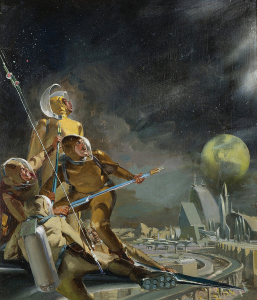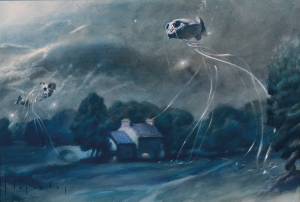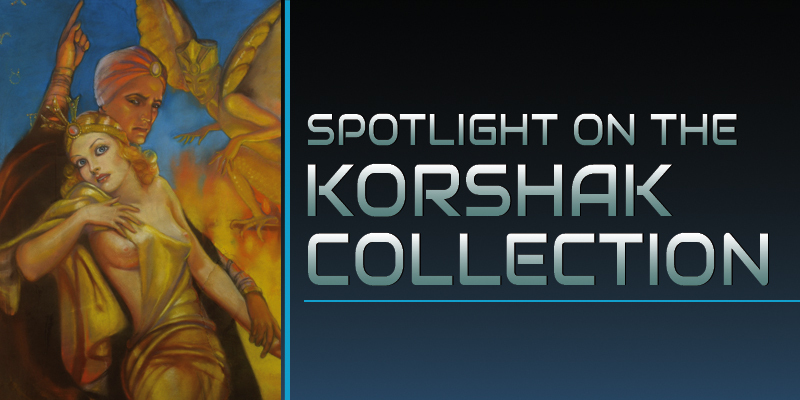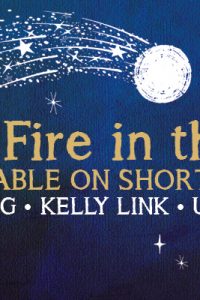Spotlight on The Korshak Collection
The Korshak Collection: Illustrations of Imaginative Literature spans 135 years of illustration history and includes artwork by pioneering European and American artists in the field of imaginative illustration. Thoughtfully compiled to include iconic artwork by renowned fantasy illustrators alongside lesser-known but equally influential contemporary illustrators, the collection serves as an educational resource highlighting the evolution of fantasy illustration from the Golden Age through the late-20th century. Selections of paintings, drawings, and sculpture from the collection have been exhibited at 13 museums in the United States, Spain, and Japan. Artwork from the Korshak Collection is currently on display at the University of Chicago Lab Schools’ Corvus Gallery through November and will be exhibited from late January to May of 2023 at the Bozeman Art Museum (Bozeman MT). A published catalog of the Korshak Collection is forthcoming.
Tell us a bit about the history of the collection. How did it begin? What was the role of Shasta Publications in the early history of the collection?
The inspiration for the Korshak collection began when Erle Korshak placed a J. Allen St. John illustration for ‘‘The City of Mummies’’ in his young son, Stephen Korshak’s bedroom. The illustration inspired in Stephen a sense of wonder which later encouraged him to begin the Korshak collection. The collection started with five Shasta Publishers book cover illustrations that Stephen retrieved from Shasta’s archives. For the ensuing 40 years, he, Erle, and his wife, Alma, were on a treasure hunt for the iconic illustrations that make up the collection.

If you had to pick just a couple of highlight pieces from the collection to talk about, which would they be and why?
Stanley Meltzoff (1917-2006) – ‘‘The Green Hills of Earth’’, 1952. Although the time Meltzoff spent illustrating science fiction art was brief, the quality and style of his work elevated the look of science fiction cover art from the pulp aesthetic of the time. Meltzoff was close friends with fellow artist James Avati and together they shared a studio space in Red Bank, New Jersey. The Red Bank School of illustration influenced artists such as Paul Lehr and John Schoenherr. Even though Meltzoff produced only a small number of paintings in the field, he is considered one of the most important imaginative illustration artists of the 1950s.
Harry Clarke (1889-1931) – ‘‘The Pit and the Pendulum’’, 1919. Clarke is well known for the stylized appearance of his drawings, influenced by Aubrey Beardsley’s ‘‘decadent’’ look. He used elongated figures, solid flat areas, and large amounts of delicate and elaborate details. His macabre works for Edgar Allan Poe are considered by many to be a definitive treatment of Poe’s stories.
Jose Segrelles (1885-1969) – ‘‘War of the Worlds’’, 1933. Segrelles was a prolific Spanish illustrator whose work made a lasting impact in the field, but who has largely been forgotten by modern audiences. Segrelles illustrated comic books, mystery novels, adventure tales, editions of Faust, the Illiad, Poe’s Tales of Mystery and Imagination, and periodicals including American Weekly, The London Illustrated News, and The Sketch in – which War of the Worlds appeared. His unique perspectives and theatrical lighting effects were revolutionary. His artwork inspired Roy Krenkel and Frank Frazetta, and also greatly influenced the filmmaker Guillermo del Toro. Looking at this piece, it’s difficult to believe that it was created almost 100 years ago – it appears more like concept art for a modern film.

The collection contains many important historical works – are there any plans to continue to expand it to include newer works? Talk a bit about what relevance these works can continue to have for the artists and audiences of today.
It is not possible to include every great illustrator in any collection so we have decided to leave it to another collection to include newer works. We feel that the collection, as it stands now, is a good narrative of many of the visual highlights of the imaginative illustration field. These illustrations reveal much of the visual vocabulary that is still used today by modern illustrators.

Are there any conservation challenges or interesting stories from the curation side that you’d like to share with us? Take us behind the scenes!
One challenge to caring for illustration artwork is preservation. Illustrations on paper were created using commercial paper and paper board that is acidic and deteriorates over time. The artwork wasn’t intended to last forever; just through the publishing process. For example, the Korshak Collection includes two pastel paintings by the artist Margaret Brundage. Pastel paintings are very delicate and prone to pigment loss if measures aren’t taken to prevent it. Both paintings exhibit image loss and tears/subsequent repairs that are the product of the artwork not being cared for like a fine art object. Great care goes into how each painting is framed and housed to prevent further deterioration to every piece in the collection now, but some damage can’t always be undone.
 Cover and interview art and design by Francesca Myman
Cover and interview art and design by Francesca Myman
While you are here, please take a moment to support Locus with a one-time or recurring donation. We rely on reader donations to keep the magazine and site going, and would like to keep the site paywall free, but WE NEED YOUR FINANCIAL SUPPORT to continue quality coverage of the science fiction and fantasy field.
©Locus Magazine. Copyrighted material may not be republished without permission of LSFF.









